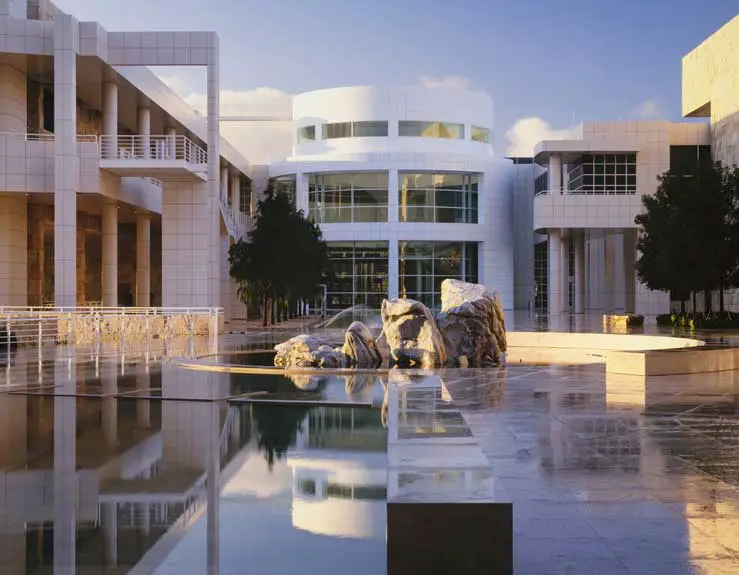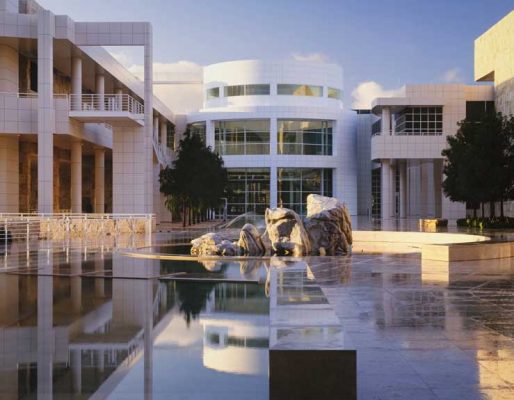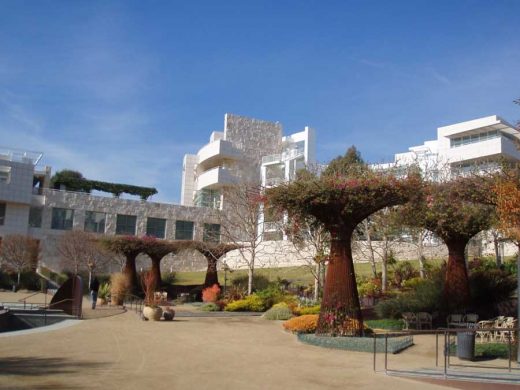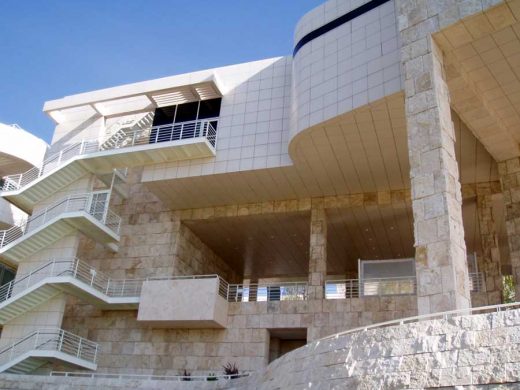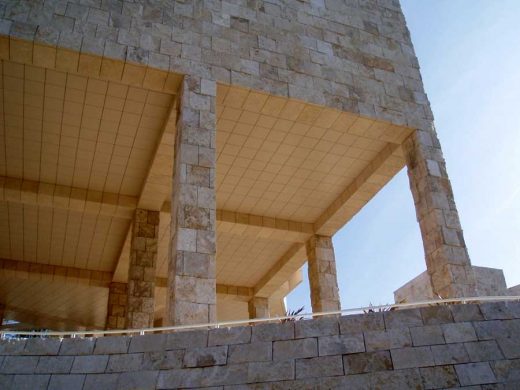Getty Center Building Architect, Los Angeles Architecture photos, Major US design
The Getty Center Los Angeles Architecture
Californian Museum Building design by architect Richard Meier, USA
post updated August 17, 2023
Thierry W Despont (1948-2023)
Thierry W Despont (1948-2023) passed away at his home in Southampton NY on Sunday, August 13th, 2023.
During the 1980s, he worked alongside wolrd-famous US architect Richard Meier on The Getty Center.
The French architect and interior designer had lived and worked in New York City.
Jan 8, 2013
Location: 1200 Getty Center Drive, Los Angeles, California
Dates built: 1984-97
Design: Richard Meier & Partners with Robert Irwin; Emmet L. Wemple & Associates; Thierry W. Despont
The Getty Center
The Getty Center
Address: 1200 Getty Center Dr, Los Angeles, CA 90049, United States
Phone: +1 310-440-7300
Photos © Alice McRae:
The Getty Center, in Los Angeles, California, is a campus of the Getty Museum and other programs of the Getty Trust. The $1.3 billion Center opened in 1997 and is well known for its architecture, gardens, and views overlooking Los Angeles. The Center sits atop a hill connected to a visitors’ parking garage at the bottom of the hill by a three-car, cable-pulled hovertrain funicular.
Located in the Brentwood neighborhood of Los Angeles, the Center is one of two locations of the J. Paul Getty Museum and draws 1.3 million visitors annually. (The other location is the Getty Villa in the Pacific Palisades neighborhood of Los Angeles, California.) The Center branch of the Museum features pre-20th-century European paintings, drawings, illuminated manuscripts, sculpture, and decorative arts; and 19th- and 20th-century American, Asian, and European photographs. In addition, the Museum’s collection at the Center includes outdoor sculpture displayed on terraces and in gardens and the large Central Garden designed by Robert Irwin. Among the artworks on display is the Vincent Van Gogh painting Irises.
Designed by world-famous architect Richard Meier, the campus also houses the Getty Research Institute (GRI), the Getty Conservation Institute, the Getty Foundation, and the J. Paul Getty Trust. The Center’s design included special provisions to address concerns regarding earthquakes and fires.
Source: wikipedia
LOS ANGELES — Since opening its doors in 1997, the Getty Center has welcomed more than 20 million visitors and become a cultural destination that has played a key role in helping Los Angeles become an important leader in the arts.
Envisioned in the early 1980s as a way to bring together the Getty’s programs, properly exhibit the collection which had outgrown its previous home in Pacific Palisades, and create an inspiring public setting for the study and enjoyment of the visual arts, the Getty Center was designed by architect Richard Meier, and features the Central Garden created by artist Robert Irwin, as well as sweeping views of Los Angeles and the Pacific coast.
The Getty Center is home to the Getty Conservation Institute, Getty Foundation, J. Paul Getty Museum, and the Getty Research Institute. Together, these programs have conducted and funded research, conservation, and education programs locally, nationally, and internationally. Nearly one and a half million students, many from Title 1 schools, have augmented their arts education with visits to the Getty. And its exhibitions and public programs have given Los Angeles some of its most dramatic art experiences.
Extending far beyond the Getty Center itself, Getty collaborations with other Los Angeles cultural institutions have enriched the community’s understanding of the visual arts in all its forms. Collaborations extend around the world, as well, in research, conservation, scholarship, and exhibitions on virtually every continent.
In addition, the Getty Center has become an international center for scholarship, hosting scholars from all over the world who have come to work and study in its libraries, laboratories, galleries, and workshops.
The Getty Conservation Institute
The Getty Conservation Institute (GC) works to advance conservation practice in the visual arts, broadly interpreted to include objects, collections, architecture, and sites. It serves the conservation community through scientific research, education and training, model field projects, and the broad dissemination of the results of both its own work and the work of others in the field.
The GCI carries out its work in scientific laboratories at the Getty Center and in the field. In the laboratories, a major initiative is focused on the many and varied conservation needs of modern and contemporary art with research projects addressing conservation issues of modern paints, plastics and outdoor sculpture.
From projects in Los Angeles to collaborations in China, Peru, and Tunisia, the GCI works with a wide range of local, national, and international partners. Currently involved in more than 20 field projects on nearly every continent, the GCI, in all its endeavors, focuses on the creation and delivery of knowledge that will benefit the professionals and organizations responsible for the conservation of the world’s cultural heritage.
The Getty Foundation
The Getty Foundation fulfills the philanthropic mission of the Getty Trust by supporting individuals and institutions committed to advancing the greater understanding and preservation of the visual arts in Los Angeles and throughout the world. Through strategic grant initiatives, it strengthens art history as a global discipline, promotes the interdisciplinary practice of conservation, increases access to museum and archival collections, and develops current and future leaders in the visual arts. It carries out its work in collaboration with the other Getty Programs to ensure that they individually and collectively achieve maximum effect.
Among the Foundation’s most prominent recent initiatives was Pacific Standard Time: Art in L.A., 1945-1980, the largest cultural collaboration ever undertaken in the region. Begun in 2002 as an effort to save archival collections related to postwar art in Los Angeles, Pacific Standard Time grew into a vast initiative featuring more than 60 related exhibitions that took place across Southern California in 2011-2012. It leaves a legacy of nearly 40 publications that make a significant contribution to scholarship in this area. The newest initiative in this effort is Pacific Standard Time: LA/LA, a far-reaching and ambitious exploration of Latin American and Latino art in dialogue with Los Angeles opening September 2017.
Another is the Foundation’s Online Scholarly Catalogue Initiative (OSCI), which is helping museums face the challenges of moving collections catalogues online and unlock the potential of digital publishing. Launched in 2009, OSCI is a collaborative effort of eight museums that are working together to produce model online catalogues that can be adapted and used by the entire museum community.
The Foundation’s work is also distinguished by its international focus, providing support for projects in over 180 countries on seven continents since 1984. For example, Keeping It Modern is advancing the conservation of 20th century buildings around the world. The Panel Paintings Initiative is supporting the next generation of conservators of paintings on wood and conserving some extremely important works of art. Connecting Art Histories is bringing together scholars across national boundaries, especially from regions where economic or political constraints have hampered their research. And for nearly 30 years, the Foundation has supported projects that build the skills and knowledge of museum professionals across SubSaharan Africa, thus increasing the capacity of their institutions.
The J. Paul Getty Museum
The J. Paul Getty Museum, which consists of six buildings around a central courtyard, houses a collection which has grown substantially since Mr. Getty assembled a modest group of European paintings, a distinguished holding of Greek and Roman antiquities, and a significant collection of 18th century French decorative arts. Today the Getty Center houses the Museum’s collection of European drawings, paintings, illuminated manuscripts, sculpture, and decorative arts, from the Middle Ages to the 20th century; and photography from its beginnings to the present, gathered internationally.
The Getty’s paintings collection is on view under natural light upstairs in the North, South, East, and West pavilions. Though the paintings collection was begun by Mr. Getty himself in the 1930s, it was not until after his death that the collection grew significantly. Today the collection encompasses nearly 450 paintings from 1300-1900, of which about 75 percent are on view. Areas of particular strength include the Northern Italian Renaissance, Baroque painting from Italy and Flanders; Dutch painting of the 17th century; and French painting of the 18th and 19th centuries.
The West Pavilion also showcases the Museum’s collection of photographs in galleries that were expanded from 1,700 to 7,000 square feet in 2006. The Getty’s Department of Photographs holds one of the world’s preeminent collections of photographs from all over the world, dating from the medium’s earliest days to the present, and has made the Getty, and Los Angeles, an important center for the study of photographs.
Also in the West Pavilion are several galleries devoted to rotating exhibitions of the Getty’s distinguished and growing collection of more than 800 European drawings. The collection traces the history of Western drawing through major sheets by artists such Leonard do Vinci, Michelangelo, Rembrandt, Fragonard, Van Gogh, and Seurat.
The North Pavilion of the Getty Center is home to one of the most ambitious programs for the display of manuscripts in the world, exhibiting illuminated books on a rotating basis year-round. The manuscripts collection comprises masterpieces of Ottonia, Byzantine, Romanesque, Gothic, International style, and Renaissance illumination found in manuscripts made in Germany, France, Belgium, Italy, England, Spain, Poland, and the eastern Mediterranean.
The North Pavilion also houses European sculpture, and was recently renovated to provide a new state-of-the-art home for the collection. The galleries feature selected paintings, drawings and manuscripts alongside the Museum’s collection of sculpture and decorative arts.
In addition to the stunning sculpture on display inside the Museum, the grounds of the Getty Center display 28 modern outdoor sculptures that were donated to the Museum by the estate of the legendary film producer Ray Stark and his wife Fran. These 20th century sculptures are integrated with the environment and architecture to create a dramatic outdoor art experience, particularly in the new Fran and Ray Stark sculpture garden near the tram departure area at the bottom of the hill.
The East Pavilion is home to the Getty’s French 17th- and 18th-century decorative arts collections—one of Mr. Getty’s particular passions—which ranks among the foremost in the world. Paintings from the collection are also on view in the decorative arts galleries. In addition, the East Pavilion features the Family Room, a place for families with children of all ages to discover a world of wonders, delights, and hands-on activities.
The Getty Research Institute
The Getty Research Institute (GRI) houses one of the world’s largest art and architecture research libraries and a special collection of rare materials from antiquity to the present that includes rare books and manuscripts, prints and engravings, photographs, historic optical devices, the world’s largest repository of video art, and extensive archival material on artists, historians, art dealers, and architects. The library is open to the public, and its more than one million volumes are available to scholars, serving as an unparalleled international resource. Its special collections are shared with the public in frequent exhibitions in the GRI’s recently enlarged gallery space. The GRI hosts dozens of visiting scholars each year, who conduct research and public lectures on a single theme.
The J. Paul Getty Trust is an international cultural and philanthropic institution devoted to the visual arts that includes the J. Paul Getty Museum, the Getty Research Institute, the Getty Conservation Institute, and the Getty Foundation. The J. Paul Getty Trust and Getty programs serve a varied audience from two locations: the Getty Center in Los Angeles and the Getty Villa in Malibu.
Visiting the Getty Center
The Getty Center is open Tuesday through Friday and Sunday from 10 a.m. to 5:30 p.m., and Saturday from 10 a.m. to 9 p.m. It is closed Monday and major holidays. Admission to the Getty Center is always free. Parking is $15 per car; $10 after 5pm on Saturdays and for evening events throughout the week. No reservation is required for parking or general admission. Reservations are required for event seating and groups of 15 or more. Please call (310) 440-7300 (English or Spanish) for reservations and information. The TTY line for callers who are deaf or hearing impaired is (310) 440-7305. The Getty Center is at 1200 Getty Center Drive, Los Angeles, California
Additional information is available at www.getty.edu.
Updated 2015 – source: http://news.getty.edu/images/9036/2015gcoverview.pdf
Photographs © Andrew McRae:
The Getty Center Los Angeles architect : Richard Meier
Berlin/Los Angeles: Space for Music, Exhibition at Getty Center
Location: 1200 Getty Center Drive, Los Angeles, Southern California, United States of America
Los Angeles Buildings
Contemporary Los Angeles Architecture
L.A. Architecture Designs – chronological list
Los Angeles Architecture Tours – architectural walks by e-architect
Los Angeles Architecture Designs
The Main Museum of Los Angeles Art
Design: Tom Wiscombe Architecture
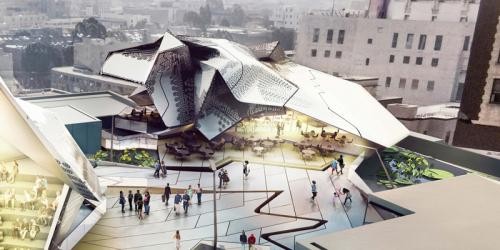
image courtesy of architects
The Main Museum of Los Angeles Art
New designs for the Lucas Museum of Narrative Art
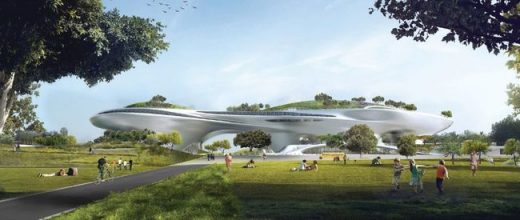
image courtesy of architects
Lucas Museum of Narrative Art Los Angeles
Comments / photos for The Getty Center Los Angeles Architecture design by Richard Meier & Partners with Robert Irwin; Emmet L. Wemple & Associates; Thierry W. Despont page welcome
Website: www.getty.edu

